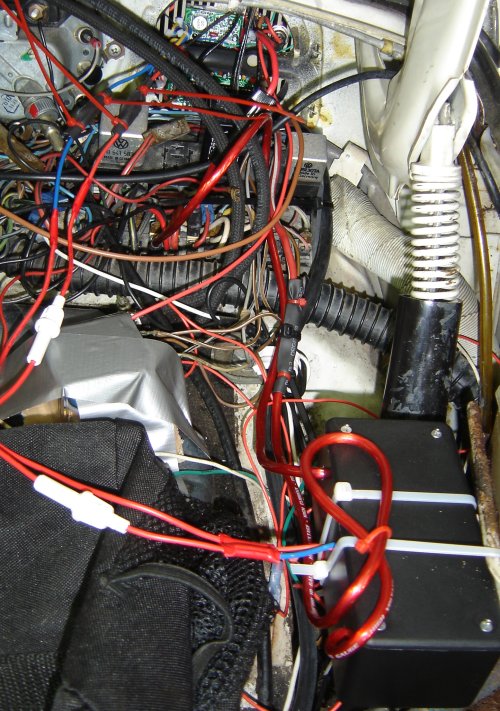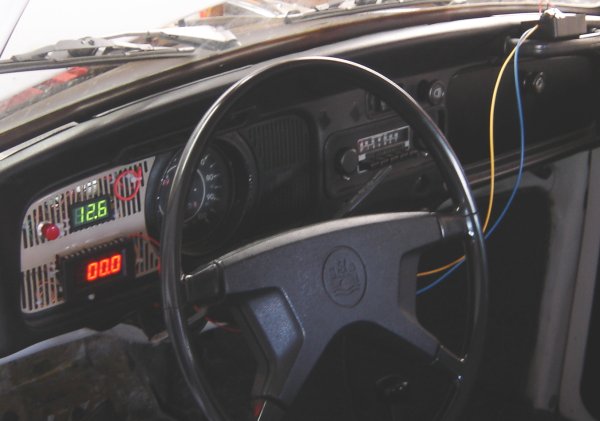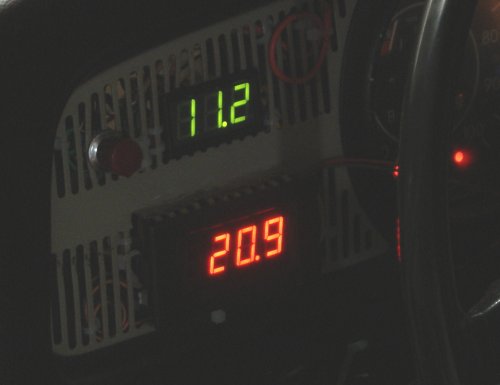I thought I was doing well yesterday. I had voltmeter and current meter set up in the beetle. I finished what I though were the final connections, and then I reconnected the battery ground strap. Big spark (meaning something's drawing a LOT of current). Uh-oh.
So it seems that the current meter that I have requires an isolated power supply--basically the "-" on the power input for the current meter is connected to the "-" on the sense input. Fortunately, the only thing I lost was the current meter.
Lesson learned. Before starting to hook a piece of electronics into any system, particularly your car, doubly particularly your vintage car, ask yourself "what happens if I hook something up ass-backwards and connect any random bit to ground?". If there answer isn't "a fuse blows" then you need to go back and re-think what you're doing. If I'd put fuses in the wires that brought the shunt voltage to the current meter, I wouldn't have smoked the meter.
So...I need an isolated power supply. This isn't such a terribly exotic device...however, its pratical availability in rural southeastern Kentucky is limited. I went to Radio Shack looking for something to use. Nothing, so I left the store degectedly. If I was a more patient person, I would have ordered an isolated-output power DC to DC converter and waited for it to arrive before shipping. However, I'm not a patient person in a certain mood, so I walked back into radio shack and got the parts for a simple, chemical-based isolated power supply:

It's a nine-volt battery wired to a 7805 regulator that puts out exactly 5 volts, which is what powers the meter. I brought the wires out through the front of the panel so that I can plug it in or not when I go to drive. This isn't the elegant solution I was envisioning, but it allowed me to get it going today. Pure stubbornness, in other words. :-)
Here's the luggage bay with everything installed.

The black box in the lower right contains the shunt. The bright red cable carries the main bus current. On the left side of the photo, you can see the two white in-line fuses in the shunt voltage wires to prevent any more mis-haps from mis-wiring. At the top of the photo you can see the backs of the meters through what was the speaker grill in the original design of the car.
What I've been working on. Huzzah! (Note the box at the very upper right of the photo; that's powering the current meter.)

The top meter is the voltage (in volts) at the main wire from the battery as it enters the front luggage compartment. The bottom is the current in amperes coming through that same wire. So effectively it's the voltage and current of the entire electrical system.
Now I can start using the meters to characterize the electrical system. A few preliminary values:
key on: 5.5A
key on + low beams: 14.3A
key on + high beams: 17.7A
key on + high beams + brake lights: 20.9A (at which point the votage has dropped to 11.2V)

The red lights to the right of the meters are the warning lights at the bottom of the speedometer. The generator light is mostly covered up by the steering wheel.
I also tried plugging in one of the halogen bulb sport headlights from Mid-America Motorworks. The headlight connector fit. On each low beam and high beam, the sport headlight drew about one amp more on one side. Not too bad.
By the way, I'd like to give a shout out to the outfit that I bought the panel mount meters from. Discrete panel mount meters seem to be going the way of the Dodo. They're very hard to find in even catalog stores. How I found an outfit called colfusionx who sells these and other electronics on ebay. The meters are cheap and they deliver the product as described. They don't send instructions, I guess they assume that you know what you're doing. (If I'd first measured the resistance between the terminals on the current meter OR had proper fuses in the shunt wires, it would not have been a problem). One thing is they have been VERY responsive to my e-mails. Twice I've written to them with a question, and someone got back to me within 12 hours. The most recent time was to tell me that "no, I can't use the current meter to measure its own poser supply, and yes that will fry the meter, so you have to use an isolated power supply" and that was what I needed to hear. So anyone reading this who's interested in panel-mount electronic meters, I would recommend these guys.
Incidentally, they also sell output-isolated power supplies, so I think I'll pick one up.